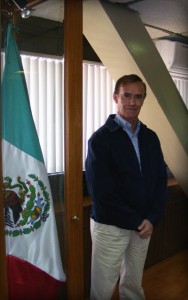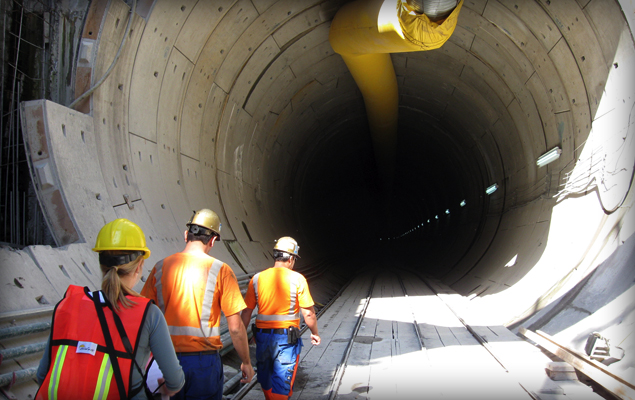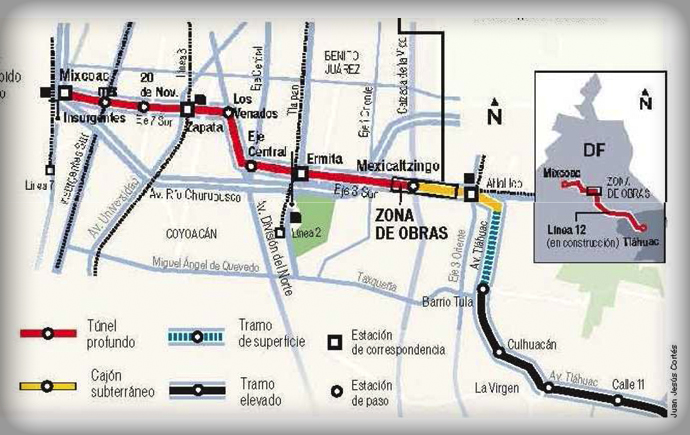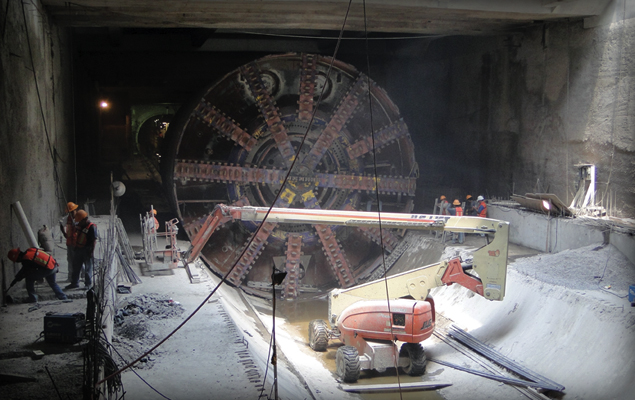罗宾斯博客
Visiting Mexico City’s Newest Metro Tunnel: How the Country’s Capital is Upgrading its Aging Infrastructure
I was lucky enough to visit the jobsite of the Mexico City Metro Line 12 tunnel in October, along with Tunnels & Tunnelling International’s features editor Nicole Robinson. The country’s largest TBM, a 10.2 m (33.5 ft) diameter Robbins EPB, is excavating Mexico’s first new rail route in 10 years, below southern areas of the city. The 7.7 km (4.8 mi) long Mexico City Metro Line 12 is being excavated just 7 m (23 ft) below downtown areas in mixed ground including watery clay and boulders up to 800 mm (32 in) in diameter. The project is one of two major tunnels being constructed in Mexico City, the other being the 62 km (39 mi) long Emisor Oriente wastewater project, using six TBMs including three 8.93 m (29.3 ft) diameter Robbins EPBs.
During our visit to the site, the machine was between its first and second cut and cover station sites (it will hole through into seven such sites during the course of tunneling). We walked through the tunnel to view the machine, and later sat down with metro director Enrique Horcasitas of the Mexican Federal District for an interview on the current state of tunneling in Mexico.
Interview with Metro Director Enrique Horcasitas

Q: Were other methods besides tunneling with an EPB TBM considered for this tunnel?
A: Originally, the line was envisioned to be constructed using a technique of slurry walls cast in place. Most of Mexico City’s underground lines were built using this method. However, opening and closing city streets was not possible for a large portion of this route, while open cutting would interfere with existing municipal facilities and fragile archeological sites. In addition, cost estimates placed open cut excavation of the entire 24 km (15 mi) line at 19.5 billion pesos (USD $1.57 billion).
Our engineers needed a solution that would reduce risks and adverse impacts to traffic flow, as well as reduce project cost. For several weeks, methods were studied, and it was ultimately determined that a solution using multiple methods would work best. The 7.7 km (4.8 mi) long tunnel between Mexicaltzingo and Mixcoac would be excavated using a mixed ground EPB TBM, while the rest of the line between Atatonilco and Tláhuac, in much more difficult ground, would be constructed on the surface. Smaller portions of the tunnel would be constructed using cut and cover methods. The overall plan has a budget of 17.58 billion pesos (USD $1.41 billion).
Q: What does the city forecast for future ridership?
A: In the short term, it is expected this project will meet an average demand of 437,000 users per weekday. By 2030, this number is expected to grow to 600,000 users.
Q: How was the route of this line determined?
A: There is a long history associated with Mexico City’s metro plan. Engineers used to think it was impossible to excavate underground, given Mexico City’s highly complex geology. But in the 1950s and 60s, crews hand-mined the city’s main wastewater line, Emisor Central, about 100 m (330 ft) below ground. After the encouraging results, about 41 years ago, the project’s current contractor ICA (Ingenieros Civiles Asociados) began to make feasibility studies about metro lines running through the city. ICA was contracted to excavate the capital’s first metro lines, and 10 years later ICA gave the Federal District a gift: A master plan with over 300 km (185 mi) of rail that would serve as our template for decades to come.
The master plan is reviewed every 10 years, and it was most recently determined to build Line 12. The alignment is almost entirely true to the master plan, though it was made a bit longer after being reviewed by advisors, to match public demand for transportation.
Q: Are there any other metro expansions that the city is considering?
A: We are looking at doing an extension of the new Line 12, depending on the available budget. This extension would include 1,400 m (4,600 ft) of tunnels west of Mixcoac.
The next line we are considering in the master plan is Line 15, which would run directly below Insurgentes, the longest avenue in the world (18.8 km/11.7 mi), which goes straight through the city. A metro is absolutely needed on this route, as there are currently about 10,000 people per hour riding on just buses alone in each direction.
Q: Do you think current opinion about TBMs is changing in Mexico? What is the current climate towards TBMs?
A: I think the public can see the success of this tunnel—we arrived into the first station with precision, only 1 cm (0.4 in) to the side. We are monitoring settlement, and have detected only about 2 cm (0.8 in) at maximum—well within the limits and not enough to affect buildings. The public voted on where to excavate the next new line, they decided where to go, and so there is a consensus in society. I think that is why there has been a high degree of acceptance.
The operation of TBMs is seen as more favorable than hand mining or open cut, because there is less inconvenience at the surface, and building the tunnel itself is safer. For this reason, I think TBM tunneling will continue to increase in Mexico.
With the six TBMs currently excavating or being readied to excavate the new Emisor Oriente wastewater line, we now have seven TBMs operating in the country—this has never happened before. I think this is a tunneling boom!

 Close
Close  Menu
Menu 


